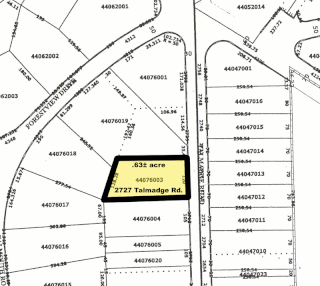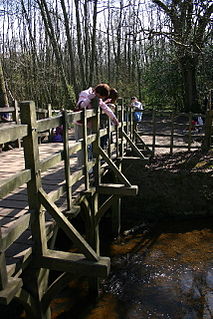In United States constitutional law, a regulatory taking occurs when governmental regulations limit the use of private property to such a degree that the landowner is effectively deprived of all economically reasonable use or value of their property. Under the Fifth Amendment to the United States Constitution governments are required to pay just compensation for such takings. The amendment is incorporated to the states via the Due Process Clause of the Fourteenth Amendment.
Adverse possession, sometimes colloquially described as "squatter's rights", is a legal principle in the Anglo-American common law under which a person who does not have legal title to a piece of property—usually land —may acquire legal ownership based on continuous possession or occupation of the property without the permission (licence) of its legal owner. The possession by a person is not adverse if they are in possession as a tenant or licensee of the legal owner.

In the United States, a plat (plan) is a cadastral map, drawn to scale, showing the divisions of a piece of land. United States General Land Office surveyors drafted township plats of Public Lands Surveys to show the distance and bearing between section corners, sometimes including topographic or vegetation information. City, town or village plats show subdivisions broken into blocks with streets and alleys. Further refinement often splits blocks into individual lots, usually for the purpose of selling the described lots; this has become known as subdivision.

Common land is land owned by a person or collectively by a number of persons, over which other persons have certain common rights, such as to allow their livestock to graze upon it, to collect wood, or to cut turf for fuel.
Water right in water law refers to the right of a user to use water from a water source, e.g., a river, stream, pond or source of groundwater. In areas with plentiful water and few users, such systems are generally not complicated or contentious. In other areas, especially arid areas where irrigation is practiced, such systems are often the source of conflict, both legal and physical. Some systems treat surface water and ground water in the same manner, while others use different principles for each.

Cuius est solum, eius est usque ad coelum et ad inferos is a principle of property law, stating that property holders have rights not only to the plot of land itself, but also the air above and the ground below. The principle is often referred to in its abbreviated form as the ad coelum doctrine.

A cadastre or cadaster is a comprehensive recording of the real estate or real property's metes-and-bounds of a country. Often it is represented graphically in a cadastral map.
Title 18 of the United States Code is the main criminal code of the federal government of the United States. The Title deals with federal crimes and criminal procedure. In its coverage, Title 18 is similar to most U.S. state criminal codes, which typically are referred to by such names as Penal Code, Criminal Code, or Crimes Code. Typical of state criminal codes is the California Penal Code. Many U.S. state criminal codes, unlike the federal Title 18, are based on the Model Penal Code promulgated by the American Law Institute.
A great pond in the United States is a pond or lake that is held in trust by the state for public use. Generally, any natural body of water that is larger than 10 acres (40,000 m2) in size is public water. In certain New England states, this legal definition exists at both common law and statutory law.
Head v. Amoskeag Mfg. Co., 113 U.S. 9 (1885), was a U.S. Supreme Court case considering whether a dam constructed on privately owned land served a public purpose and whether having the owner of the dam compensate any adjacent landowner was a legal form of eminent domain.
Spot zoning is the application of zoning to a specific parcel or parcels of land within a larger zoned area when the rezoning is usually at odds with a city's master plan and current zoning restrictions. Spot zoning may be ruled invalid as an "arbitrary, capricious and unreasonable treatment" of a limited parcel of land by a local zoning ordinance. While zoning regulates the land use in whole districts, spot zoning makes unjustified exceptions for a parcel or parcels within a district.
An easement is a nonpossessory right to use and/or enter onto the real property of another without possessing it. It is "best typified in the right of way which one landowner, A, may enjoy over the land of another, B". An easement is a property right and type of incorporeal property in itself at common law in most jurisdictions.
Solid Waste Agency of Northern Cook County (SWANCC) v. U.S. Army Corps of Engineers, 531 U.S. 159 (2001), was a decision by the US Supreme Court that interpreted a provision of the Clean Water Act. Section 404 of the Act requires permits for the discharge of dredged or fill materials into "navigable waters," which is defined by the Act as "waters of the United States." That provision was the basis for the federal wetlands-permitting program.
Water law in the United States refers to the Water resources law laws regulating water as a resource in the United States. Beyond issues common to all jurisdictions attempting to regulate water's uses, water law in the United States must contend with:

The Prevention of Illegal Squatting Act, Act No 52 of 1951, formed part of the apartheid system of racial segregation in South Africa. This act authorized the forcible removal of squatting communities. It allowed eviction and destruction of homes of squatters by landowners, local authorities, and government officials. It was commenced on 6 July 1951.
The Alberta Municipal Government Board (MGB) is a provincial quasi-judicial tribunal in Alberta, Canada. The MGB is affiliated with the Alberta Ministry of Municipal Affairs. The MGB is established pursuant to the Municipal Government Act (MGA), which authorizes it to hear: appeals from subdivision applications involving a provincial interest, appeals of linear property assessments, intermunicipal disputes, municipal annexations, and other matters.

In English common law, real property, real estate, immovable property or, solely in the US, realty, is land which is the property of some person and all structures integrated with or affixed to the land, including crops, buildings, machinery, wells, dams, ponds, mines, canals, and roads, among other things. The term is historic, arising from the now-discontinued form of action, which distinguished between real property disputes and personal property disputes. Personal property, or personalty, was, and continues to be, all property that is not real property.
General Land Office Easements were legal mechanisms which created right of way to ensure future access through, and to the interior of, lots or parcels created by the U.S. Small Tract Act of 1938,.

The policies protecting land used in Big Sur are some of the most restrictive local-use standards in California, and are widely regarded as one of the most restrictive development protections anywhere. The program protects viewsheds from the highway and many vantage points, and severely restricts the density of development. About 60% of the coastal region is owned by governmental or private agencies which do not allow any development. The majority of the interior region is part of the Los Padres National Forest, Ventana Wilderness, Silver Peak Wilderness or Fort Hunter Liggett. The area is protected by the Big Sur Local Coastal Plan, which preserves it as "open space, a small residential community, and agricultural ranching." Its intention is "preserving the environment and visual access to it, the policies of the local coastal plan are to minimize, or limit, all destination activities."
Cedar Point Nursery v. Hassid, 594 U.S. ___ (2021), was a United States Supreme Court case involving eminent domain and labor relations. In its decision, the Court held that a regulation made pursuant to the California Agricultural Labor Relations Act that required agricultural employers to allow labor organizers to regularly access their property for the purposes of union recruitment constituted a per se taking under the Fifth Amendment. Consequently, the regulation may not be enforced unless “just compensation” is provided to the employers.






